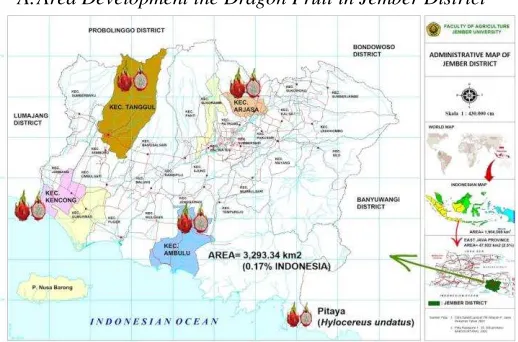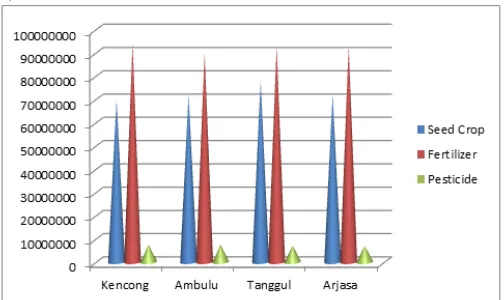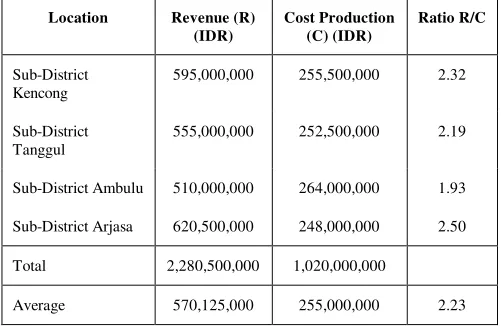Abstract—The development of the dragon fruit plant (dragon fruit) in Indonesia can be designed as a source of new growth in the national economy, because it will add value to farmers (producers) and industrial users (consumers). In Indonesia an increase in national fruit production is still very possible, with the use of seed (varieties) and the application of technological innovation. Based on the description above, the problems in the farming of dragon fruits in Jember, Indonesia is related to the efficiency of use of the means of production and the cost of production, farming profit, the feasibility of farming, as well as the efficient use of production factors from farming and marketing that are running in Jember, Indonesia.
This study aims to determine the implementation of the system of farming carried out by the dragon fruit farmers. The data in this study are primary and secondary data. The data is taken from dragon fruit farms in Jember during the 2014 planting season.
The method used in this research is the descriptive method, a method in researching the status of a group of people, an object, a set of conditions, a system of thoughts or a class of events in the present time. The goal is to create a systematic, factual and accurate description based on facts and thethe relationship between the phenomena investigated.
The results showed that the dragon fruit farming and cultivaiton in the area of research is very profitable and feasible to be developed. The estimated efficiency test results indicated that the use of the production factors of the land area, the amount of manure, the amount of inorganic fertilizer, and the amount of liquid fertilizer in the farming of dragon fruit is not yet efficient, while the use of the seedlings as a production factor is inefficient. Production factors such as the frequency of watering and dummy variables (fields and orchards) are known to affect dragon fruit production insignificantly. Technical problems are basically related to funding and the lack of experience of farmers in the cultivation of patchouli, while the non-technical problems include a lack of capital and fluctuative commodity expectations.
Keywords—Dragon fruit, Agribusiness, Invesment.
Sigit Soeparjono, Lecturer, Faculty of Agriculture University of Jember, Indonesia
I. INTRODUCTION
HIS Agricultural-based economic activities have a very
strategic meaning in an agrarian country such as Indonesia. Business-wise, economic activities which rely on horticultural crops is the largest business activity and it is spread widely throughout Indonesi (15). This is supporteed by the agro-ecological conditions that can produce almost all kinds of fruit, including those originating from the subtropical climates. Furthermore, the agricultural land in Indonesia that can be used to develop fruit crops amounts to a total of around 35 million hectares. Although almost all types of fruit can be produced in Indonesia, the national productivity of fruit is still low, at the rate of 7,5 tones/ha. The potential of natural resources presents an opportunity to vastly increase the production of various types of fruit, with the use of superior production facilities and the application of technological innovations. The development of the agribusiness-patterned commodity of fruit has a very bright prospect as the demand for the commodity tends to increase, whether that be in domestic or international markets (13). As a kind of an agribusiness company only includes economic activity alone ( a corporate network ) , while as an integrated system , in addition to covering the consumer , the state of the macro economy and supporting institutions (4).
One type of tropical fruit that has a bright prospect for development is the dragon fruit, also called the pitaya fruit. The dragon fruit is a type of fruit of several cactus species of the genus Hylocereus and Selenicereus. It was originally regarded as an ornamental plant and has already been known for quite some time by the people of Taiwan, Vietnam, and Thailand. In this subfamily there are several genera, whith the dragon fruit belonging to the genus of Hylocereus. This genus comprises about 16 species. Four of them have commercial fruit, namely Hylocereusundatus (red-coloured with white flesh), Hylocereuspolyrhizus (pink-coloured with red flesh), Selenicereusmegalanthus (yellow-coloured with white flesh) and Hylocereuscostaricensis (exceptionally
vabrant red flesh, or “super red”). Each dragon fruit has its
own characteristics, but the red-fleshed dragon fruit has more often been cultivated because it has its own advantages, such the larger fruit size and the more attractive colour of its flesh (9).
Accurate and appropiate farm management is one option to improve the agribusiness system to increase the economic activity along with the farmer’s income. Agribusiness is
Dragon Fruit Agribusiness Investment in
Jember District, Indonesia
Sigit Soeparjono
T
Int'l Journal of Advances in Agricultural & Environmental Engg. (IJAAEE) Vol. 2, Issue 2 (2015) ISSN 2349-1523 EISSN 2349-1531
divided into three sectors of activity that are economically interdependent, namely the input, the production (farm) and the output. The input provides supplies to the farmer to produce crops. Included in the input sector is the means of production or material (7).
In Jember, East Java, Indonesia, the agribusiness of dragon fruit has been cultivated since 2005 until today and has been growing rapidly. Development areas for dragon fruit cultivation in Jember are located in four districts: Ambulu, Kencong, Tanggul and Arjasa. The types dragon fruit cultivated in Jember are the white-fleshed type (Hylocereusundatus) and the super red-fleshed type (Hylocereuscostaricensis). Seeing favorable prospects and opportunities, Jember has a great potential to develop dragon fruit on a wider scale with added value and to improve the welfare of farmers. Related to that is the neccessity of studies and reviews of agribusiness and investment opportunities in the development of dragon fruit. This is aimed to obatin information about the prospects for agribusiness development in order to support the sustainability of the highly competitive and valuable dragon fruit investment in Jember, East Java, Indonesia.
II.RESEARCH METHOD
The research was conducted in 2014 in four sample districts in Jember, East Java, Indonesia, which are the districts of Ambulu, Kencong, Tanggul and Arjasa. This type of data consists of primary data obtained from the fruit farmers and secondary data obtained from the departments or agencies as well as the publication of scientific papers, with the technique of collecting data through observation, interviews, and recording directly on the field of the respondents which are farmers that cultivate dragon fruit. Data and information are presented in an informatively descriptive manner. To determine the level of feasibility of the dragon fruit agribusiness, the simple financial analysis approach of R/C is used, which is the ratio between the total revenue (R) and the total production cost (C). If the R/C>1 = business is feasible to be developed, and if the R/C<1 = business is not feasible to proceed.
III. RESULTS AND DISCUSSION
A.Area Development the Dragon Fruit in Jember District
Fig. 1: Location of research: Four Sub-Districts ( Tanggul, Kencong, Ambulu and Arjasa) of the Jember District, East Java ,
Indonesia
Jember is a district that is part of the province of East Java. It is located on the slopes of the Argopuro Mountain that stretches to the ocean south of Indonesia. Regionally, Jember has a strategic position and role as one of the Regional Activity Centers/RAC (Pusat Kegiatan Wilayah/PKW). It has an area of 3,293,34 km2 or 0.17% of the territory of Indonesia (Figure 1), and has areas which are potential for the development of fruit trees such as banana, durian, papaya, pineapple and dragon fruit. Sub District of Tanggul, Kencong, Ambulu and Arjasa that are sampling area of research during 2014 season. All area sampling have geographical circumstances which strongly supports for the development ofdragon fruit commodities . Dragon fruit that comes from the area sub district known sweeter than other areas with potential productivity average about 3500 kg every season.
B.Application of Cultivation Technology
One important factor in the development of dragon fruit plants are the aspects of cultivation and the understanding of farmers on continuous and correct application of crop cultivation technologies. Agronomy-wise, dragon fruit plants do not require complex growth requirements. The dragon plant can grow at 30 to 550 m above sea level on soil that is porous, has a loose texture and is rich in organic matter with a pH of 5-7. Adequate water should be availabe because these plants are sensitive to drought but will rot if the amount of water is excessive, and it requires full sunlight exposure to accelerate the flowering process. Dragon fruit plants are resistant to fluctuations in temperature but will be damaged at temperatures of more than 39oC so which postpones the flowering process (9). Excessive shade intensity can cause the lack of light and temperatures that are too low, resulting in stunted plant growth. During the day the shade acts as a means to reduce the very high maximum temperature by withstanding the sunlight received by plants and at night the shade reduces the drop in the minimum temperature by Int'l Journal of Advances in Agricultural & Environmental Engg. (IJAAEE) Vol. 2, Issue 2 (2015) ISSN 2349-1523 EISSN 2349-1531
inhibiting the radiation of heat from the earth into the atmosphere.
Dragon fruit production in the four sampling districts of the Jember Regency is quite high compared to other regions, which is caused by agro-ecological and agro-climatic conditions that suit the needs of dragon fruit plants. Additionally, the production of dragon fruit is also supported by the human resources of the farmers in those areas wich are capable enough to apply the technology of cultivation of dragon fruit properly. (9). The dragon fruit cultivation technologies developed, among others, are as follows: (i) the preparation of planting material or dragon fruit seedlings is done vegetatively by taking 80% of the fruitful branches or vines (cut at a length of 25-30 cm) to be used as seed; (ii) the planting of the material which has 2-4 stem cuttings for each planting pole/stake is done at a depth of 5-7cm, with a distance of 10cm from the base and is then tied tightly; (iii) the controlling and fastening of branches is done every 21-25cm; (iv) the application of organic fertilizers or manure is given circuling around the plant by using, if necessary, the addition of dolomite with a ratio of 10 kg of manure and 300g of dolomite for each pole/stake; (v) the pruning to shape the main stem is done by choosing the buds located at the edge whilst the base of the shoots are trimmed (the pruning is repeated for a length of 1-2cm if the most top shoot has reached the end of the stake, and it is also done for shoots that grow on the bottom of the plant); (vi) the controlling of plant pests is performed regularly once a week, as well as to recognize and identify the symptoms of the attacks, the type of pests and its natural enemies (1) .Some diseases and pests that often attack the dragon fruit plants are the rotting of stems, the rotting bacteria, Fusarium, mites, lice, snails and squirrels. Pest control can be done mechanically and chemically; (vii) harvesting is done when the maturity level has reached 80-90%. Technology development should be felt in the effort to address the economic problems faced . Thus the pattern of development of the technology called induced innovation (8).
C.Analysis of farming cultivation of dragon fruit at four sub district
Fixed costs on the farm of dragon fruits in Jember consist of leases of land, farm equipment and poles crop for all sampling areas did not show significant differences . The cost of land lease on average in the four sub-districts reached from IDR 50500000 to IDR 57500000 for five years, while the cost of the purchase of agricultural equipment the mean reaching from IDR 8350000 to IDR 105500000 and installation costs poles flattened crops reached from IDR 6000000 to IDR 7500000 ( Figure 2 ).
Fig. 2: Analysis of Cost for Land Leases, Farm Tools and Poles at Four Sub District
The variable costs consist of seedling, fertilizer and pesticide for all sampling areas did not show significant differences. The cost of seedling on average in the four sub-districts reached from IDR 70000000 to IDR 78000000 for five years, while the cost of the fertilizer every year the mean reaching from IDR 9000000 to IDR 94000000 and purchases pesticide reached from IDR 7000000 to IDR 7500000 (Figure 3).
Fig. 3: Analysis of Cost for Seed Crop, Fertilizer and Pesticide at Four Sub District
The labour costs on the farm of dragon fruits consist of land tillage, cost of planting, cost of cultivation and harvesting for all sampling areas sub district was shown significant differences . The cost of land tillage on average in the four sub-districts reached from IDR 6000000 to IDR 7000000 for every season, while the cost of the planting the mean reaching from IDR 4500000 to IDR 5000000 and cultivation costs reached from IDR 4000000 to IDR 4500000, for harvesting cost reaches from IDR 2000000 to IDR 2500000 (Figure 4 ).
Int'l Journal of Advances in Agricultural & Environmental Engg. (IJAAEE) Vol. 2, Issue 2 (2015) ISSN 2349-1523 EISSN 2349-1531
Fig. 4: Analysis of Cost for Land Tillage, Planting, Cultivation and Harvesting at Four Sub District
Based on data analysis in Figure 2 , 3 and 4 can be seen that the cost of production and labor for agribusiness dragon fruit in Jember in four districts of sampling can be seen that the cost of production for all the districts are relatively equal , but for labor costs turned out to districts Arjasa have cost lower compared to other districts . Optimizing the use of factors of production , in principle, is how to use factors of production as efficient as possible . In terms of economics , the notion of efficiency can be classified into three types namely (14).
The analysis of the cultivation of “super red” dragon fruit in Jember shows the R/C ratio of 2.23. Benefit cost ratio is an analysis that is usually done due to its easiness in application, which is the ratio between revenues and costs of production. If the value of the R/C ratio is less than 1, the project is not economically feasible. Contrary, if the R/C ratio is larger than 1, the project is economically feasible, and if the R/C ratio equals 1 then that the project is marginal (no loss and no gain) . The analysis of the farming cultivation of dragon fruit uses the area of 1 ha in four sampling districts in the district of Jember, as presented in Table 1.
TABLE I:ANALYSIS OF DRAGON FRUIT FARM IN FOUR SAMPLING DISTRICTS
Location Revenue (R)
(IDR)
Cost Production (C) (IDR)
Ratio R/C
Sub-District Kencong
595,000,000 255,500,000 2.32
Sub-District Tanggul
555,000,000 252,500,000 2.19
Sub-District Ambulu 510,000,000 264,000,000 1.93
Sub-District Arjasa 620,500,000 248,000,000 2.50
Total 2,280,500,000 1,020,000,000
Average 570,125,000 255,000,000 2.23
Table 1 shown that the results of the analysis of dragon fruit cultivation in Jember gives a profit of IDR 570.12 million with production costs reaching only IDR 255.0 million in the harvest period of the first year, meaning that the dragon fruit cultivation in the researched areas are feasible to be developed. Opportunities to gain greater revenues can be
achieved when the dragon fruit cultivation is carried out on a
farmer’s own land whilst also minimalizing the use of
employees, along with the support of adequate equipment and production facilities. Agribusiness done to encourage activities that are backward linkages on agriculture and economic activities that are forword linkagges which leads to the final consumer (10)
IV. CONCLUSION
Dragon fruit development opportunities in District Jember has good prospects because supported by the climatic conditions and soil texture appropriate circumstances and the introduction of specific technology right. The analysis of farming of 2.23 which means that the development of dragon fruit commodities are very feasible and prospects for business investment in Jember district, Indonesia.
REFERENCES
[1] Ariyanto , H. 2006. Cultivation of Fruits. PT. Aji image Parmana . Yogyakarta.
[2] Davis.J.HH and R.A.Golberg. 1977. A. Concept of Agribusine. Graduate School of Busines Administration, Harvard University;
[3] Desai,D.E. 1974. Evaluasion of concept of agribusine and its application. Indian juornal of Agricultural Economic. 29(4):32-43;
[4] Dillon,J.D. 1971. Agribusines Management Resource Materials (vol 1). Asian Productivity Management Organization;
[5] Golberg,R.A and R.C.Mc Ginity. 1979. Agribusines Management of Developing Countries-Soutriest Asian Corn System and American and Japanese Trends Affecting it. Balinger Publishing Company;
[6] Hastuti DR and Rahim A. 2007. Agricultural Economics ( introductory, Theory , and the case ) . Penebar Organization. Jakarta
[7] Hastuti DR and Rahim A. 2007 in Downey and Erickson. 1992. Agribusiness Management (second edition) (translation: Alphonsus Sirait ) . Erland . Jakarta.
[8] Hayami,Y and V.W.Ruttan. 1991. Agricultural Development. John Hopkins University Pres, Baltimore;
[9] Krisanto, D. 2008. Dragon Fruit cultivation in pots and in the garden . Penebar Organization. Jakarata.
[10] Kinsey. 1987. Agribusines and Rural Enterprise Croom Hellm. New York; [11] Nainggolan,K. 1988. Macroekonomic impests on Indonesia agricultural
exports. Ekonomi Keuangan Indonesia: 36(2):163-189;
[12] Schuch,E.G. 1974. The exchange rate and U.S. Agricultural. American Juornal Agricultural Economics: 56:1-13.
http://dx.doi.org/10.2307/1239342
[13] Saragih, B. 2001. Agribusiness (New Paradigm Based Economic Development of Agriculture). Yayasan Mulia Persada Indonesia. Bogor. [14] Soekartawi . 1991. Theory and Application. PT. King Grafindo Persada.
Jakarta
[15] Soekartawi. 1987. Basic Principles of Agricultural Economics Theory and Application. CV. Rajawali. Jakarta.
Int'l Journal of Advances in Agricultural & Environmental Engg. (IJAAEE) Vol. 2, Issue 2 (2015) ISSN 2349-1523 EISSN 2349-1531


